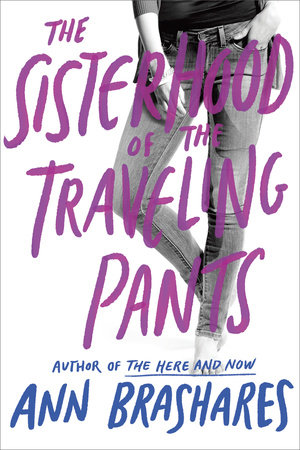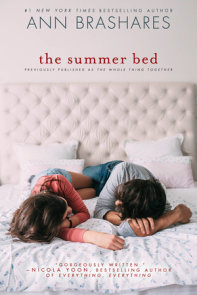Author Q&A
Q: The Sisterhood of the Traveling Pants, your debut novel, received many awards, much critical praise, and adoration from readers of all ages. What are your thoughts on its success and why do you think it
resonated so strongly with readers?
A: Its success has been a wonderful surprise each step of the way. From the outset I tried to keep my expectations very low. I know how hard it is to get a book published, let alone have it succeed. I’ve read many excellent books that did not succeed commercially. Here I give credit to the publisher, Random House, and to the booksellers. They supported the book wholeheartedly. To the extent that it has resonated with readers, I am grateful for it. I sense that they have responded, more than anything else, to the unconditional love and loyalty that the Sisterhood represents.
Q: A list of main characters in The Sisterhood of the Traveling Pants could include the Pants. They’re not just a symbol of the strong bond between the four girls, but they also take on a life of their own, becoming a caretaker in some scenes or even a benevolent higher power. What inspired you to write about such a magical pair of jeans? Was it based on a real-life experience?
A: I love the idea of taking a bunch of big, abstract concepts—love, honesty, power, magic—and stuffing them all into a mundane, concrete, everyday object. The Pants are that object. I’ve always loved the idea of enchanted clothing. I like to imagine that clothes can hold transformational power, and that somehow they can hold memories and emotions in their fibers.
The Pants were, in part, inspired by a real story—that of a friend and colleague named Jodi Anderson, who did actually share a pair of jeans with her close friends.
Q: How did you become a writer? What do you love most about writing? What advice do you have for aspiring writers?
A: I still feel self-conscious when I call myself a writer—I haven’t been one for very long. I came to it very slowly and with utmost caution. My career has been spent around books, but for ten years I was too frightened to actually try to write one. I edited them, I wrote outlines for them, I worked closely with authors, I even rewrote big sections of other people’s books on occasion. I always long to master a thing before I feel safe enough to try it. Which is totally illogical, of course.
The part of writing I love most is when I achieve a feeling of deep involvement with a character. It never happens right away. I have to spend a lot of time with a character before I feel that union. I know it has happened when I stop telling my character what to do and she starts telling me. It’s kind of like the Velveteen Rabbit moment when a beloved fiction becomes real.
I also feel self-conscious about giving advice, being rather new to this. But here goes. First, don’t think you can’t be a writer because you haven’t known you were destined to be a writer from the beginning of your life. Writers can become writers at different stages. And yes, some do start early. Second, write about characters you know how to love. That doesn’t mean they shouldn’t have flaws; they absolutely must. It’s their struggle that makes us truly love them. But be sympathetic. Your readers won’t connect if you don’t.
Q: Your novel is both humorous and poignant. You deal honestly with death, divorce, sex—what sorts of issues would you like to write about in the future?
A: I don’t really think of myself as writing about issues. The stories naturally include issues, but they don’t usually start with them. I like to go after big emotions, and tragedies are often the way to get them. Only I’m not so much interested in racy, headline-grabbing tragedies. I’m more interested in the kinds that happen to people every day.
Q: Which girl would you have identified the most with in high school? Which character do you identify with the most now?
A: In high school I think I would have identified most with a combination of Tibby and Lena—the cautious ones. Now . . . hmmm . . . I think I still identify with the Tibby/Lena combo. I guess I haven’t made all that much progress.
Q: Before the girls set off on their separate adventures, Carmen says “magic comes in many forms” (p. 20). Do you believe in magic? If you could own a piece of magical clothing, what would it be and why?
A: I believe in a subtle kind of magic, I guess. I tend to imbue objects with intentions and abilities—not earthshaking, but modest ones. My son had this pair of pajamas that kept him safe and snug for hundreds and hundreds of nights. With all the washing and folding and putting them on and taking them off, I spent a lot of time with those pajamas. When at last they were reduced to rags and I had to throw them out, I took a few minutes to thank them and kiss them goodbye. That’s a bit strange, I guess.
Which brings me to the magical piece of clothing I would wish to own. I think it would be a garment I could trust to keep the people I love safe. Kind of like fire-retardant fabric, only more powerful and less itchy. But I confess that’s the mother in me talking. As a writer, I’ve designed a fabric that challenges as often as it protects.
Q: One of the prevailing themes of The Sisterhood of the Traveling Pants is the importance of friendship. Did you realize when you were writing the book that it was going to be about friendship, or did this theme develop as you explored the characters during the writing process?
A: The book started with the Pants, and as such, it was always about what was communal and transitional. Which I guess is to say that the book started out being about friendship. What surprised me, in writing it, was how much the individual stories took over. An abstract idea like friendship, inspiring though it may be, is not as compelling as characters coming to life—not to me, at least.
Q: If you could meet only one of the Sisterhood for coffee, who would it be and why? What would you talk about?
A: I think I would choose to meet Bridget. Not because I love her the most (I do love her, but it feels wrong to play favorites) but because she is the one I worry about the most. She has enormous gifts, but she also has some pretty big deficits. Because she hasn’t got a mother, I think I feel more maternal toward her.
That’s not to say that coffee with her would be all serious. Bee’s got buzz even without any caffeine.
Q: An important part of the book is the characters’ self-discovery, but just as important is the characters’ discovery that there is more to other people than what you see on the outside. Carmen realizes there’s more to her dad’s new family than “being blond together.” Tibby realizes there’s much more to those starring in her “suckumentary” than she could ever hope to understand. Lena discovers that Kostos is far from being a stalker. Bridget is the only one of the four who doesn’t make an important discovery about another person. Her experience with Eric only accentuates how little she knows about him as well as how little she understands the mental and emotional consequences of their intimacy. Her journey seems to be the most introspective, and although at the end she’s comforted by the Pants and her friends, she is left very confused. Why did you choose to make Bridget’s story more introspective than the others?
A: Bridget is the character who knows herself least. While the other three characters often look inward, Bee looks out. So, being the taskmaster I am, I sent the other three out, out, out of their (sometimes) selfish and insular worlds, and I sent Bridget in. Her journey toward knowledge had to start with self-knowledge. I wanted to give her an experience that would shake her up. Bee thinks she can be blithe about her intimacy with Eric, but she simply can’t. She is forced to suffer the wounds in the center of herself. And those don’t heal quickly or easily.
Q: Do you have a sisterhood of your own?
A: Not quite like the one I write about. I have very close friends from different times in my life. I have close friends from childhood and high school. I have two close friends from college. I have a play group with other mothers whom I love (including my sister-in-law and my cousin). I would say I have overlapping sisterhoods.
Q: The four friends learn about themselves as individuals by being on their own. They’re forced to be stronger than when they were together. What do you think this means in regard to friendship?
A: Carmen notes that the four girls of the Sisterhood sometimes feel like four parts of one person. Being on her own forces each of the girls to become a whole person, to develop the parts of herself that get less use. Friends are the ultimate support, but they can also insulate you from the world and even stunt your growth. The friendship in this novel proves its power by giving support while spurring the girls toward independence.
Q: Was it difficult to structure the novel by alternating among four unique points of view?
A: It wasn’t really difficult, because I wrote the main part of each girl’s story separately. Toward the end I felt like a movie editor splicing all of my scenes together. When I was done I honestly couldn’t tell if it was a book or a big pile of nonsense. I had one clear operating rule: When in doubt, don’t reorient, don’t recap, don’t rehash. Just throw the reader right into the middle. Chances are she’ll stay with you. My faith in the reader has probably been my best gamble.
Q: Readers certainly will approach the companion books to The Sisterhood of the Traveling Pants with their own hopes and expectations. How does that affect your writing?
A: I can’t help being affected by that. It’s a great honor to have people care about your book and your characters. You don’t want to disappoint them. It affected me to the point of total paralysis at the outset of writing both the second and third books. But after a while I have to figure it’s my job to write books. It’s my job to figure out what happens to these girls, and if I do my honest best . . . well, what else can I do? Readers so far have been pretty forgiving. And, anyway, once I get started writing, I stop questioning myself and pay attention to the important people—my characters.
Q: What can you tell us about Girls in Pants: The Third Summer of the Sisterhood?
A: I can tell you that it takes place right after the girls’ high school graduation and tells the story of their last summer before they split up for college. I can also tell you that Tibby falls in love for the first time and that Bridget once again encounters Eric Richman, the soccer coach. But I’d better be quiet now, before I give too much away. . . .































